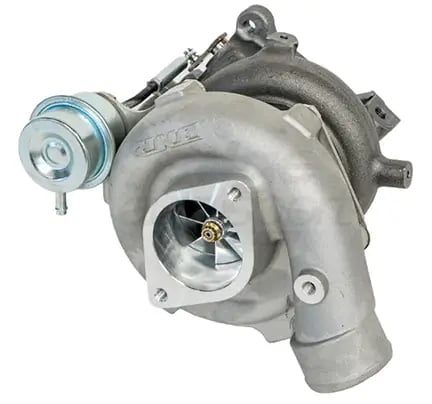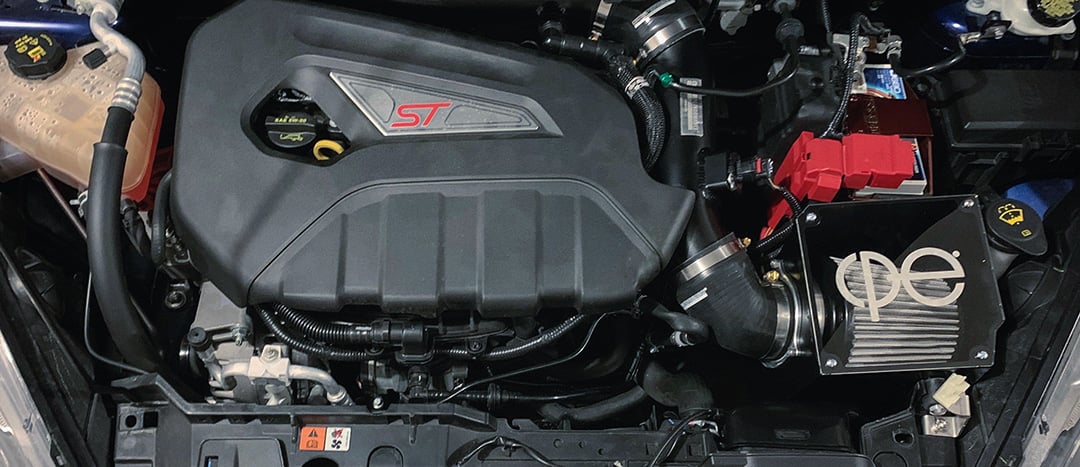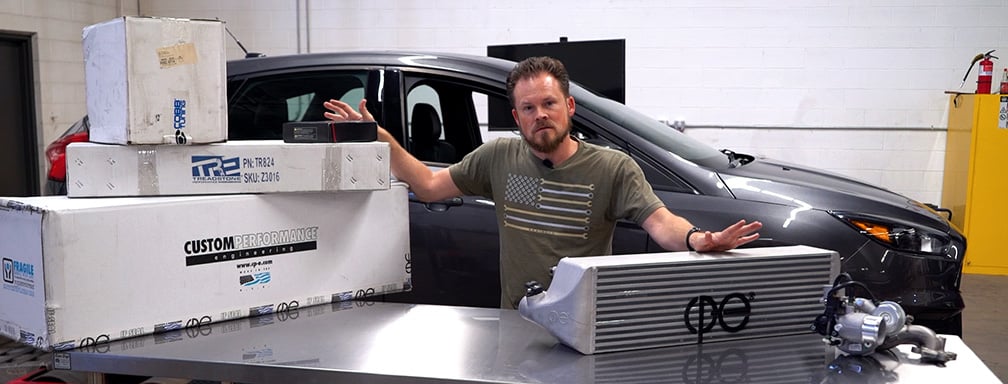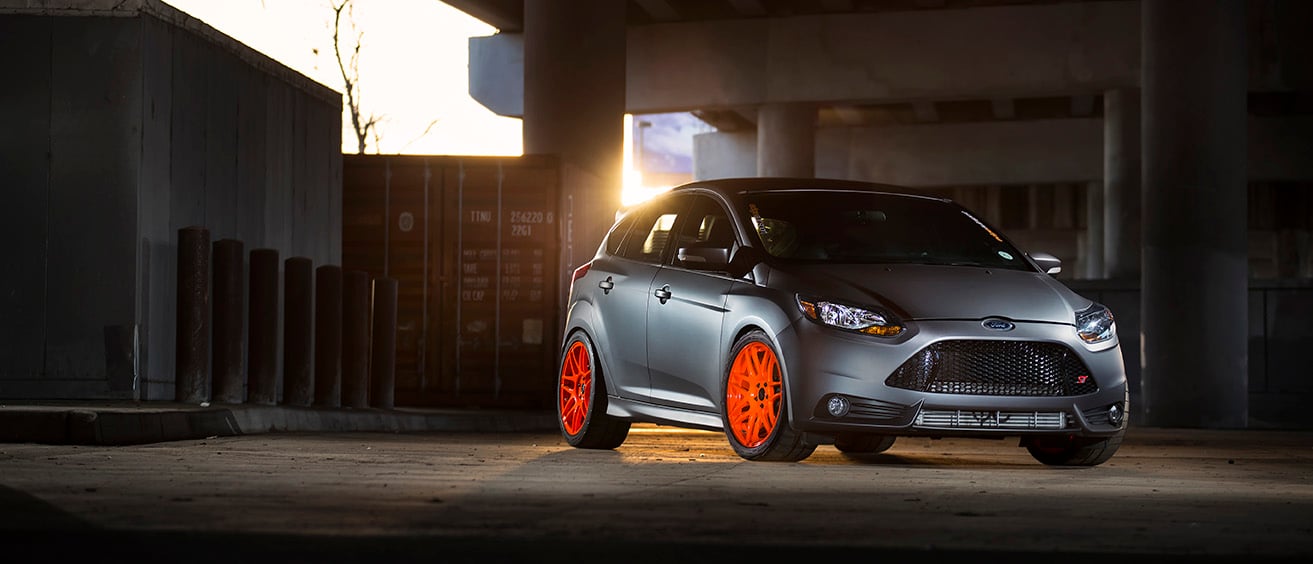
Ever wondered if the hype is real? Here's your answer. Hell yes. Be careful though, if you take the plunge on a big turbo, prepare to never be satisfied with a stock turbo car ever again. It just won't be the same. The experience of a hard wide open throttle pull, holding 22psi, or more, all the way to 7,000 glorious rpm makes you mad that Ford gave you such a puny hair dryer of a turbo now that you know what boost can really feel like.
Why do you think we do this for a living? It's addicting and exhilarating, to say the least. You'll find yourself wanting to go for a drive at odd times, maybe even enjoying the drive to work in the morning when the air is cool and crisp, leaving early because you're taking the long way.
A bigger turbo is more than a turbo though, it's a commitment. It's not cheap and it needs supporting modifications and tuning. It's not hard to do, but it's not foolproof. We had one of the very first Focus ST's with a bigger turbo once ATP Turbo released their Garrett based bolt-on kits. We're super thankful for companies like this that make it so easy to go bolt on some big power. We want to pay it forward and try to help you understand what's involved and what turbo fits best for you.
.jpg?width=780&height=519&name=Big%20Turbo%20Upgrade%20-%20The%20Ultimate%20Focus%20ST%20Mod%20(10).jpg)
Preparing for Big Power
The difference between a stock turbo and a big turbo is significant. The amount of air being forced into the engine takes a huge leap. This requires more support from the surrounding components to perform and if they aren't up to snuff, it might be harmful or limit your power and efficiency. Here are the minimum supporting modifications we suggest to make a big turbo kit work properly.
ECU Tuner and Custom Calibration
The only thing I'm going to tell you is you need it. You cannot put a bigger turbo on without it. Plain and simple. You probably already knew that, but some people ask.
Intercooler and Downpipe
I listed both of these parts at once because they are equally important. Turbos need as little exhaust restriction after the turbo as possible to make good power. Not relieving exhaust pressure well enough can raise your EGTs (exhaust gas temperature), prevent you from running higher timing, and ultimately leaves power and efficiency on the table. The downpipe is the first one in line responsible for clearing out that pressure and gas. It must be free flowing.
On the intake side, nothing is more important than the intercooler. The temperature of the air coming out of turbo is mind blowing. Without being cooled down, your engine would suffer severely. Any intercooler helps cool down the air, but some don't do it well enough. The stock intercooler doesn't work great on the stock setup, so how would it ever work on a big turbo? It doesn't. You need a core that has more volume, denser fin structure, and quality construction.
Intake
The intake system in the Focus ST is about as long as an intake gets. The longer it is, the harder the turbo has to work to ingest air. There is actually pressure loss (of the atmospheric air) occurring in the intake system before it sees the compressor blades. The longer and more restrictive it is, the more pressure loss. In a perfect world, you would put a velocity stack right on the end of the turbo compressor and call it good. That's obviously not realistic for this car but putting a smooth flowing, larger diameter tube on the intake system will help the turbo breathe better.
Cat-Back Exhaust
Some will argue this isn't a huge necessity but in reality, it is. Just like I was describing before about the downpipe, the same applies with the exhaust. It's only a 2.0 liter engine but a bigger turbo is easily forcing up to twice the amount of air, or more, through the engine when compared to the stock turbo car. That means there is an equal amount more exhaust being generated. All that pressure needs to be released to make efficient power. A catback exhaust might not have as big of an effect on a stock turbo car, but on a big turbo setup, you're leaving a lot of power on the table without upgrading it.
Fueling Modifications
I can't talk about upgrading a turbo without at least mentioning this. I'll make this brief because fueling is a bigger conversation we've talked about elsewhere. Technically you don't need any fueling mods to put on a bigger turbo. Just understand that no matter what turbo you have, you're going to be limited to roughly 360-370whp. So if your plan is to never upgrade the stock fuel system, pick a turbo that stays within that range or slightly higher to give you some cushion, like the GTX2867 Gen2, for example. If you're wondering if it's worth getting a new turbo without fueling mods, the answer is hell yes. 100whp more than a stock turbo car with all the bolt-ons will turn your Focus ST into an absolute animal.
Choosing the Turbo
Okay, let's get to the good stuff. There are MANY options. I'll break down the most popular Turbos and the ones I think make the most sense for the ST. I'll also share some differences in the options for these turbos, mainly turbine housing sizes.
Before we go further, I want to bring something to your attention that many people are hesitant about when considering a turbo upgrade. Although you'll lose a little low end punch with these bigger turbos, you'll actually INCREASE the amount of usable range of power. For example, the stock turbo spools around 2800 rpm but falls off badly around 5500 rpm. It actually doesn't help you to stay in the throttle past that point. Let's pretend you lose 800 rpm of low end torque and hit peak boost at 3600 rpm now. Although you lost 800 rpm of usable boost, you gained as much as 1500 rpm at the top end because you will hold your boost level all the way to 7000 rpm or higher if you are pushing it harder. That's a net gain of 700 more rpm of usable power, just something to consider.
ATP Turbo
ATP was the first to market for a bolt-on big turbo. The kits are complete and fit really well. We know because we were one of the first ones to use one on our own Focus ST in the form of a GTX2867. Since then, the GTX Gen2 turbos have been released and they're very impressive. Even later than that, Garrett release the G-Series turbos which flow like crazy for their size. ATP adapted their turbine housing castings to this newest performance turbo making the best Garrett turbos available to Focus ST owners in a true bolt-on format.
The ATP turbo kits fit with the stock style downpipe and the stock style intake system. It comes with all the oil and coolant lines for the new turbo setup. All ATP kits come with an expansion port for an external wastegate. The internal wastegate works well so don't feel like you need to use the external setup. With the G-25 and G-30 turbos, you MUST use the external wastegate. They don't have internal wastegate functionality. If you're dead set on external wastegate but don't want the G-Series, the GTX2867R Gen2, GTX3071R Gen2, and GTX3076R Gen2 are all available without the IWG (Internal Waste Gate) function.
.jpg?width=640&name=Big%20Turbo%20Upgrade%20-%20The%20Ultimate%20Focus%20ST%20Mod%20(8).jpg) |
.jpg?width=640&name=Big%20Turbo%20Upgrade%20-%20The%20Ultimate%20Focus%20ST%20Mod%20(7).jpg) |
Complete List of ATP Turbo Kit Options, All Garrett Turbo Based
With this list, we've decided to eliminate the GTX Gen1 versions. All Gen1 versions are available in a Gen2 version except for the 2863 and 2871 models. And if you wanted one of those, you would simply select the GTX2860 Gen2 or the GTX2867 Gen2, respectively. There's really no reason why you would select a Gen1 over a Gen2. It's the same size and price in a better flowing turbo. The reason why we've included GT series turbos is because they are a less expensive alternative, which might contribute to your decision.
| GT Series - GT2860RS, GT2871R, GT3071R GTX Gen 2 - GTX2860, GTX2867, GTX3071, GTX3076 G-Series - G25-550, G25-660, G30-660, G30-770 |
GT-Series
These three turbos feature ball bearing housings that spin freely but they feature the older style cast aluminum compressor wheel. Many years ago, these were ahead of their time in the aftermarket but have long since been updated with many iterations. Garrett still offers them as a less expensive alternative and for many turbo kits that were produced around them throughout the years. Although these will spool quickly and give you an awesome chunk of power and torque that wasn't there before, don't count on surpassing the 400whp mark with the 28 series. But if you want a solid 325-350whp in a fast spooling package that doesn't cost an arm and a leg, the GT2860RS is a great choice. The GT2871 will get you around 400whp but it'll be stretching at that point. The GT3071 will get to 400 but the slower spool is what makes this turbo not as desirable if you're not considering it for the low price.
GTX Gen2 Series
The GTX2860R Gen2 features ball bearings and a machined compressor wheel. This little powerhouse has such good spool characteristics while being able to crank out over 400whp. Honestly, if I was shooting for a good street car setup on the stock fuel system or maybe just an upgraded XDI pump, this is the turbo to get, no question about it.
The GTX2867R Gen2 is next in line. It's a bigger compressor version of the GTX2860. So it'll hit boost slightly later than the 2860 but it'll be able to hold a little higher pressure and flow a little more air. It's worth about 40-50 more whp than the 2860, perfect for those that might be upgrading their fuel system to go past the stock limits, but without sacrificing quicker spool and good streetability.
With the 3071 and 3076 models, you're just moving the powerband a little further to the right and upward. They will spool slightly slower again compared to the 2867 but will allow for more boost and more power once boost reaches it's peak. If you are looking for 450whp or more, these are great options, especially if you want to retain the internal wastegate. Plan on seeing full boost hit in the high 3000rpm range. After that, 600whp is achievable with the 3076.
G-Series
These turbos are Garrett's latest and greatest. They are more aerodynamic and have more advanced material and machining than what the GTX Gen2 predecessors had. Not to say those are bad turbos now. But damn, the G-Series flow a ton of air given their size. And they spool faster compared to similar sized turbos. With that said, they are more expensive and are only available in an EWG package, at least in the Focus ST bolt-on format from ATP Turbo. These turbos are for someone that's pretty serious about the performance of their ST and don't care so much about practicality and budget. Don't think because you don't fit into the G-Series mold, that you have to choose from a defective parts bin. Garrett's entire line of turbos is worth every dollar you spend on it.
ATP Turbo/Garrett Turbine Housing OptionsAll GT and GTX Gen2 Series with IWG - 0.64 or 0.86 A/R As a general rule, the smaller housing gives you faster spool, but lower top end power capability. The larger housing gives you slower spool, but allows more boost and power at the top end. I think some people pick a larger A/R because they think the disparity between the two is big and they won't reach their power goals. With the Focus ST, it's not. The fuel system probably has a bigger impact on peak power potential than the turbine A/R choice. On street cars, the usable power range is the most important trait, IMO. For that reason, unless you only care about a number on a dyno or you are drag racing your ST and live at high rpm, I would recommend the smaller A/R in almost all normal circumstances. |
cp-e
Just like ATP, cp-e bases their kit around a Garrett turbocharger. However, it's a completely different animal. cp-e's kit uses the Tial V-Band in/out stainless steel turbine housing. This opens up your turbo selection possibilities a bit more. This is a very well designed and efficient kit. All parts come with the kit to make it completely bolt-on. The cast adapter elbow is a beautiful piece that incorporates an external wastegate design and feeds exhaust gases back through the downpipe for a recirculated design. This gives you the best boost control while not being too loud and complicated. From our experience, this is the best overall turbo kit on the market today for the Focus ST.
One thing to note about this kit in particular is the power difference when compared to the ATP bolt-on kits. Because of the more efficient design, you will have more power from this kit using the same exact turbo from another kit. The turbine housing and wastegate designs just allow for more efficiency which will allow for a better flowing, more powerful setup.
.jpg?width=640&name=Big%20Turbo%20Upgrade%20-%20The%20Ultimate%20Focus%20ST%20Mod%20(4).jpg) |
.jpg?width=640&name=Big%20Turbo%20Upgrade%20-%20The%20Ultimate%20Focus%20ST%20Mod%20(2).jpg) |
.jpg?width=640&name=Big%20Turbo%20Upgrade%20-%20The%20Ultimate%20Focus%20ST%20Mod%20(1).jpg) |
.jpg?width=471&height=313&name=Big%20Turbo%20Upgrade%20-%20The%20Ultimate%20Focus%20ST%20Mod%20(3).jpg) |
Turbo Options for cp-e Focus ST Turbo KitAll GT and GTX 28R (Gen1 and 2) Turbos - 0.52, 0.64, or 0.86 A/R |
BNR Turbos
The Focus ST turbo kit market has a couple newcomers from BNR, the ST67 and the ST71. Similarly sized to Garrett's 2867 and 3071 models, they feature journal bearing CHRAs and machined compressor wheels. Internal wastegates are standard issue on both of them with no ability to switch to external. These turbo kits are a great value with great power potential. The ST67 is capable of about 420whp while the ST71 will do around 480whp. As always, different setups and engines produce different power levels. All hardware required to mate this to the Focus ST is included. All stock style supporting modifications like the downpipe and intake will mate up, as well.

Mountune
The mountune kit is a very simple one that allows you to bolt on a lot more power using an EFR based turbo. The kit is based on the EFR T25 flanged 6258, 6758, and 7163 turbos. Each of which will provide a large increase in power on your ST. It features a cast exhaust outlet elbow to mate to the turbo, as well as, a silicone intake pipe and a downpipe. My favorite part about this kit is the oil and coolant lines. They are hard piped and pre-bent, just like a factory style system. In addition, you can even retain the factory heat shield, a huge plus. This makes fitment spot-on and the user experience will be very good.
.jpg?width=640&name=Big%20Turbo%20Upgrade%20-%20The%20Ultimate%20Focus%20ST%20Mod%20(5).jpg) |
.jpg?width=640&name=Big%20Turbo%20Upgrade%20-%20The%20Ultimate%20Focus%20ST%20Mod%20(6).jpg) |
BorgWarner EFR Turbo Options
|
Bolting up a bigger turbo can be a very rewarding experience on the Focus ST. Often times, we hear people questioning why they didn't do it sooner. With the tuning ability of the ECU using a Cobb AccessPort, or similar device, and the aftermarket part support available for the Focus ST, a big turbo is not a large feat anymore. It's as easy as adding it to the cart, waiting for it to arrive, and taking a weekend to install. If you think you're ready, go for it and never look back!
This post was originally published in September, 2017 but has been updated to reflect current parts and accurate information!
I'm the founder of Edge Autosport and I remember first getting into cars in high school. I read all the magazines, bought a bunch of technical books, and finally got to start wrenching around the age of 19. I really enjoy modding and being able to live out a passion is truly awesome. I wouldn't change a thing.
Topics:


%20-%20Does%20Your%20Big%20Turbo%20Need%20It/EWGKit-web-(2).jpg?width=1018&height=449&name=EWGKit-web-(2).jpg)



.jpg?width=1024&height=299&name=Putting%20Down%20400whp%20In%20Your%20Focus%20ST%20(2.1).jpg)









